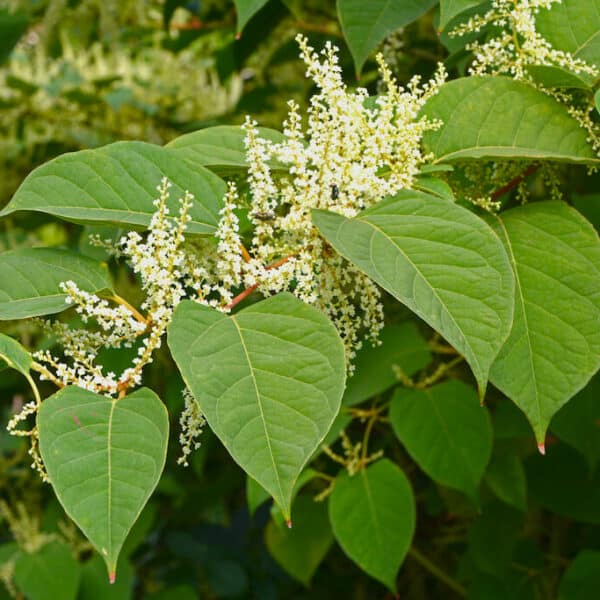All You Should Know About The Invasive Bohemian Knotweed
Bohemian knotweed is a hybrid between the invasive Japanese knotweed species and giant knotweeds, both of which are invasive species. It has been classified as a noxious weed due to its ability to spread rapidly without any natural predators in North America, where it was initially introduced for ornamental purposes. The lack of control mechanisms makes this plant particularly challenging when dealing with infestations. As such, measures must be taken promptly upon discovery to prevent further growth or migration into other areas.
If you are concerned that you have any type of knotweed or invasive weed on your property, Green Leaf Remediation Services can help. Call us on 01269 591651 or 07531 142316 or complete our online contact form and we can arrange a free, no-obligation site survey for you.
Identifying Bohemian Knotweed (Fallopia X Bohemica)
Distinguishing between different types of knotweed can be challenging, especially when they share similar physical characteristics. However, one key feature that sets Bohemian Knotweed plants apart from Japanese and Giant varieties is its unique leaf shape: heart-shaped with clusters of short, broad-based hairs along the mid-vein underside. Compared to other species, these hairs are shorter but more substantial while also being less wavy than those found on giant knotweeds, which have barely noticeable bumps instead.
The bohemian knotweed flowers have small greenish-white to creamy-white flowers that are erect or loosely drooping and occasionally produce seeds. They can have both male and female flower parts to self-fertilise, but they are also found with only female or male flower parts.
By paying attention to this detail, you’ll find it easier to identify whether or not you’re dealing with a problematic invasive plant in your garden!
Bohemian knotweed, or Fallopia x bohemia, is a plant that can grow up to ten feet tall with stout and cane-like stems and extensive roots. Its unique appearance persists throughout the winter due to its hardy nature, which allows it to survive harsh weather conditions. The flowers on this species are small but plume-like, while those found on giant knotweed have longer clusters compared to Japanese knotweeds, barely noticeable bumps. Finally, the fruit produced by Bohemian Knotweed has three sides and appears shiny black in colour.
Invasive Species
Bohemian knotweed is often found in areas that have been disrupted, such as flood zones, riparian regions, and along waterways. This invasive plant spreads at a faster rate than either of its parent species through stem or root fragments, which produce new shoots. Additionally, male plants can be produced by this aggressive weed. To identify infestation sites, look for root fragments left behind from previous growth cycles. The presence of these telltale signs should alert you to the need for immediate action against this destructive pest before it takes over your landscape completely!
Bohemian knotweed is relatively rare in the UK; however, there have been several cases found within the UK, and due to its invasive growth, this is likely to increase. Knotweed is notorious for its ability to spread rapidly and establish itself deeply within the soil through an extensive rhizome system. This makes it challenging when trying to control infestations using mechanical methods like digging up roots alone, which may be practical only in small-scale situations.
A knotweed specialist like ourselves, Green Leaf Remediation, can treat and manage any type of knotweed using certified herbicides, which offer control if applied correctly without harming nearby native plants during treatment sessions. It is crucial that all stem fragments are removed from the site after the knotweed removal process since they could potentially lead to further growth elsewhere, which is illegal in the UK and you could be prosecuted for!
Knotweed will damage property, structures, foundations, and pipework if unstable and left untreated, so always use a knotweed specialist who has experience and knowledge in the treatment and removal of this invasive weed. They will provide you with a Knotweed Management Plan (JKMP) and an insurance-backed guarantee for the treatment they carry out.
Bohemian Knotweed Conclusion
In summary, Bohemian knotweed is a hybrid species resulting from the interbreeding of Japanese and giant knotweeds. It poses as an aggressive weed that’s tough to manage effectively due to its ability to thrive in disturbed areas such as flood zones or along roadsides or waterways. The most distinct feature of this plant is how it displays short, broad-based hairs on leaf undersides, particularly near mid-veins. As much as possible, preventing the further spread of this invasive species should be prioritised since controlling it can prove challenging otherwise.
FAQ
What is invasive knotweed, and why is it a problem?
Invasive knotweed is a plant species that has become problematic due to its ability to spread rapidly and displace native flora. Its impact on ecosystems can be significant, making it an issue for landowners and environmentalists alike. Understanding this threat requires awareness of what makes invasive knotweed so challenging.
Invasive knotweed species like Japanese and giant varieties pose a significant threat to disturbed areas due to their rapid spreading capabilities. Bohemian types are no different, with extensive rhizomes that enable them to outcompete native plants while damaging infrastructure or buildings through their root systems. To prevent further damage from these invasives, landowners must take action early on in identifying infestations before they become widespread problems.
What are some effective knotweed control methods?
Knotweed control can be challenging, but there are several effective methods available. One of the most common and successful approaches is herbicide application. This involves using specialised chemicals that target knotweeds without harming other plants or animals in the area. Another option is manual removal, which involves physically digging out the roots and stems of the plant. However, this method requires significant effort and expertise to ensure complete eradication. Other techniques include biological controls such as introducing natural predators into infested areas or burning the affected areas. The choice of approach depends on various factors, including location, size of infestation, budget constraints, etc. It’s essential to consult with experts before deciding on any course of action for optimal results.
What is Bohemian knotweed, and how does it differ from Japanese and giant knotweed?
Bohemian knotweed is a species of the Polygonaceae family that has been identified as an invasive plant in Europe. While it shares similarities with Japanese and giant knotweeds, there are some key differences between them. For instance, Bohemian knotweed tends to grow taller than its counterparts, upwards of 10 feet or more! Additionally, unlike other types of knotweed, which have distinctively red stems, this variety displays greenish-yellow hues instead. Despite these distinctions, though, all three plants pose significant threats due to their aggressive growth patterns and ability to disrupt local ecosystems.
Bohemian knotweed is a hybrid species that has emerged as an aggressive invasive plant due to its ability for rapid growth and spread. It derives from two parent plants – Japanese Knotweed and Giant Knotweed, both of which are known for their prolific nature in disturbed areas such as flood zones or along roadsides or waterways.
What does Bohemian Knotweed look like?
The distinguishing features of Bohemian Knotweed include heart-shaped leaves with clusters of short, broad-based hairs on the underside, particularly near midveins; these traits set it apart from other similar-looking plants like those found within its family tree. With heights reaching upwards of ten feet, this newcomer poses significant threats to native ecosystems where it may have been introduced accidentally through human activity or natural means alike. Therefore, proper identification & management strategies must be implemented promptly before further damage occurs!
What are the common names for Bohemian Knotweed?
In the UK, Bohemian Knotweed is more commonly known as “Giant Knotweed” or “Japanese Knotweed.” These names are used interchangeably to refer to the same invasive plant species, Reynoutria bohemica, which is closely related to Japanese Knotweed (Reynoutria japonica) and Giant Knotweed (Reynoutria sachalinensis). All three species are non-native species and problematic invasive plants known for their aggressive growth and ability to cause damage to structures and ecosystems in both domestic and commercial properties in both urban and rural locations.

Green Leaf Remediation
If you are concerned you have knotweed or any other invasive plant species at your home, business, or on your land, contact us today to book a free, no-obligation site survey. We will be able to identify what is growing and provide you with a realistic solution for treatment, control, or removal.
Green Leaf Remediation Qualifications
-
-
- City & Guilds NPTC Level 2
- Principles of Safe Handling & Application of Pesticides (PA1/ PA6)
- Principles of Safe Handling & Application of Pesticides near water (PA6AW)
- Herbicide Stem Injection
- Property Care Association
- The Control & Eradication of Knotweed Surveyor’s Training Course
- Qualified Technician (PCAQT) in Japanese Knotweed
- Accredited Surveyor in Japanese Knotweed
-
Our company specialises in the removal and management of Japanese Knotweed. You can be assured that the knotweed infestation is being managed effectively and by a knowledgeable and professional business with the 10-year insurance-backed guarantee we provide.
We are a family-run, fully qualified Japanese Knotweed Surveyor (JKCS). We manage and control invasive knotweed, other invasive plants, and general nuisance weeds for residential premises and property development sites in the UK. Our service areas include South Wales, West Wales, North Ceredigion, Powys, South Glamorgan, and Gwent. Our services also extend to the West Country, Shropshire, the Midlands, and Birmingham.
We also provide tree services, pollarding, crowning, pruning, and felling services through our NPTC chainsaw operators, who have extensive forestry experience.
Contact us today at 01269 591651 or 07531 142316 or complete our online contact form and we can answer any questions you have or arrange a no-obligation site survey.
You can also see some of our work on Facebook and keep up to date with projects we are working on.

Martyn works for Green Leaf Remediation as a marketing specialist. He takes great pride in creating quality content regarding Japanese knotweed.
